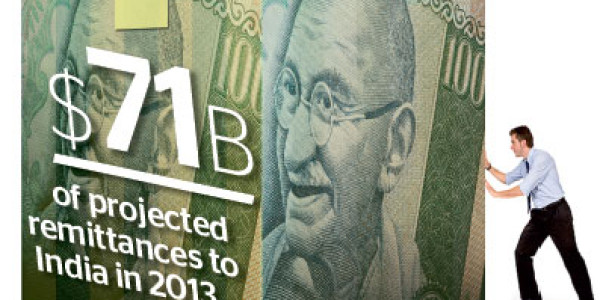Taylor Scott International News
India tops global remittances list Issac John / 4 October 2013 With the developing world on track to receive $414 billion in migrant remittances in 2013 — an increase of 6.3 per cent over the previous year — India again topped the global chart with $71 billion in remittances, according to a revised World Bank forecast. Other top recipients of officially recorded remittances for 2013 are China ($60 billion), the Philippines ($26 billion), Mexico ($22 billion), Nigeria ($21 billion), and Egypt ($20 billion), the report said. The World Bank said migrant remittances to developing world is projected to jump to $540 billion by 2016. The GCC is already the largest send market for South Asian and Mena countries, contributing close to 50 per cent of the market. It also accounted for more than 40 per cent of the total inward remittances received by the market, said Sudhesh Giriyan, vice-president & business head, Xpress Money. “GCC will continue to grow in its stature as a major remittance source bloc with countries like the UAE and Qatar lining up major development projects, particularly in infrastructure, which will, in turn, lead to more influx of expatriate labour force,” said Giriyan. India’s projected remittance receipt is just short of three times the FDI (foreign direct in-vestment) it received in 2012, when the country’s recorded $69 billion in total remittances. India and China alone will represent nearly a third of total remittances to the developing world this year, said Dilip Ratha, economist and the manager of the Migration and Remittances Unit at the World Bank. Other large recipients include Pakistan, Bangladesh, Vietnam and Ukraine. Remittance in-flows to the Middle East and North Africa region are expected to grow by 3.6 per cent in 2013 to about $49 billion. With about $20 billion in remittances anticipated in 2013, Egypt is the sixth largest beneficiary in the developing world, and receives about 40 per cent of remittances sent to the Mena region. Migration within the Mena region is growing, accounting for a growing share of migrants. The largest corridor is from Egypt to the GCC, where there are 2.4 million Egyptian migrants, including 1.3 million in Saudi Arabia alone, the World Bank said. Remittances to Lebanon and Morocco, two other large recipients in the Mena region, are expected to recover in 2013, after flat or negative growth in 2012. In 2012, the total remittances made by migrant workers in the Arab Gulf states amounted to $80 billion (representing a fifth of the global remittances), out of which 24 per cent were remitted by the migrant workers in the UAE for the same year, according to Ambassador Ahmed Al Jarman, Permanent Representative of the UAE to the United Nations at a UN roundtable. Globally, the world’s 232 million international migrants are expected to remit earnings worth $550 billion this year, and over $700 billion by 2016, says the latest issue of the World Bank’s Migration and Development Brief. As a percentage of GDP, the top recipients of remittances in 2012 were Tajikistan (48 per cent), Kyrgyz Republic (31 per cent), Lesotho and Nepal (25 per cent each), and Moldova (24 per cent). Growth of remittances has been robust in all regions of the world, except for Latin America and the Caribbean, where growth decelerated due to economic weakness in the United States. In South Asia, remittances are noticeably supporting the balance of payments. In Bangladesh, Nepal, Pakistan and Sri Lanka, remittances are larger than the national foreign exchange reserves. All these countries (most notably, Pakistan) have instituted various incentives for attracting remittances. In India, remittances are larger than the earnings from IT exports. With the weakening of the Indian rupee, a surge in remittances is expected as non-resident Indians take advantage of the cheaper goods, services and assets back home. “Fall in the rupee exchange rate and attractive interest rates on external deposits have helped drive remittances to India, thereby supporting the balance of payments situation and contributing 3.7 per cent to India’s GDP,” said Promoth Manghat, vice-president — global operations, UAE Exchange. The Indian rupee depreciated by over 20 per cent during the first three quarters of 2013, among other things due to concerns over continuing current account deficits in India and the impact of an expected tightening of monetary policy in the US, which has induced a general retrenching of international capital and reduced flows to India. While actual data have not yet been compiled for the third quarter of 2013, money transfer operators are reporting a surge in remittances, as Indian migrants benefit from a higher value of their remittances in India. Remittances to India in the first half of 2013 were $35.6 billion. issacjohn@khaleejtimes.com Taylor Scott International
Taylor Scott International, Taylor Scott








